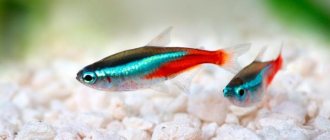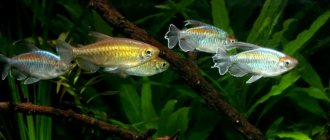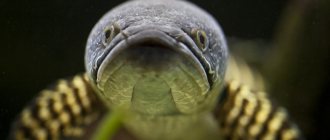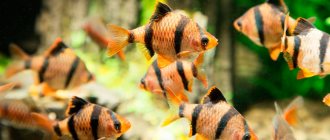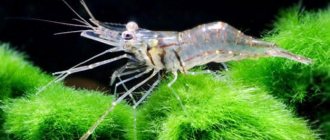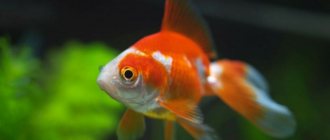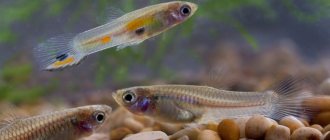Family\genus: cyprinid\danios.
Comfortable water temperature: 20-25 C.
Ph: 6,5–7,5.
Behavior: peaceful.
Compatibility of zebrafish: compatible with all peaceful fish.
Habitat and biotope: slow-flowing reservoirs of Southeast Asia.
Note that the eternal reclassification of fish, including the genus zebrafish, creates confusion among aquarists. In a nutshell - now the classification of all those who were previously called “zebrafish” is very confused. In fact, now only the former “rasboras” ( galaxy and erythromicron ) are included in the genus Danio, and even then only conditionally. All small species of zebrafish: rerio, leopard, pearl, pink, dotted, teenwini, khopra, kyatit (2 morphs), kerry, etc. - belongs to the genus Brachidanio. And the large species are Malabar, Sondhi, Dangila, etc. belongs to the genus Devario. But this classification is not final yet =) In fact, the genus Danio itself no longer exists. But who is classified as Brachydanio and who is Devario is not yet very firmly established =) Since classification by size is a conditional concept. These are the damn pies, friends!
Beautiful zebrafish
In this article, we will talk to you about the popular zebrafish. These fish often become the first pets for beginning aquarists. And for good reason! After all, these are bright, nimble, unpretentious babies that will decorate any aquarium.
Also, let's not forget about GloFish. That is, about genetically modified fluorescent fish . Zebrafish were the first fish to be modified. As a result, fish with red, green and orange fluorescent colors were obtained, which become brighter and more intense under blue or ultraviolet light.
But even without GloFish there are enough beautiful color morphs of zebrafish. There are a lot of them. The most popular are pink zebrafish, white zebrafish, gold, blue... grey-brown crimson.
But there is confusion here too. For example, “pink danios” are just a colored selection morph of the zebrafish ( Danio rerio var. rose ). The true Danio roseus are the danios now sold under the erroneous name "Danio Kerry".
And they, Danio roseus , must also be distinguished from pearl danios Danio albolineatus , which were also previously called “pink”. They are very similar to real pink ones.
The real Kerry zebrafish is:
These are the pies, friends, with these tributes!
Description of zebrafish
A small fish with a body length of up to 4.5 cm. The body is elongated, flattened laterally. Alternating blue and white stripes run along the body of the fish, starting from the gill covers and ending on the caudal fin. The caudal and anal fins are striped. The remaining fins are transparent and colorless.
Description
The Danio Rerio fish belongs to the carp family. In nature, they live in rivers and streams with large currents, so in the aquarium the flock will always be in close proximity to the air-generating filter.
They have an elongated flattened body, not exceeding 5 cm. Parallel stripes of different colors run along the sides. Depending on the time of year, adult Danios can change their color in the aquarium and become brighter.
Motherland
The birthplace of everyone's favorite Danio rerio is Asia. They can be found in large numbers in natural bodies of water stretching from Pakistan to India. Small populations of fish can also be found in the rivers of Bhutan, Bangladesh and Nepal.
Rerio was first described by Hamilton, who visited Asian countries in 1822 and became acquainted with this amazing representative of the local fauna.
Kinds
To date, scientists have classified a large number of subspecies of Danio by color. Rerio, including transgenic fish (artificially bred), can have a variety of colors:
- Danio rerio pink;
- red;
- green Danio rerio;
- voile;
- glowing;
- albinos;
- yellow Danio Rerio
- etc.
And also today there are artificially bred species of Rerio, which have very bright fluorescent colors. Among the modified fish, the following stand out: blue, orange, pink, etc. As for the green glowing Danio, this color looks unnatural, so many aquarists do not recognize it. Despite the fact that these Danios are genetically modified, no negative consequences of human intervention in nature have been observed so far. That is why they continue to be very popular among both beginners and experienced aquarists.
Care and maintenance
The aquarium fish Danio Rerio is very unpretentious, so it is easy to keep. In captivity, they are able to live in schools, so home aquariums should contain more than five representatives of this species. Life expectancy in good conditions is at least three years (maximum five).
The Danio Rerio fish should be placed in an aquarium whose length is significantly greater than its height, since it loves to chase its own kind. If you purchase a flock consisting of 10–20 individuals, then for a normal life a container with a volume of 30–70 liters will be enough for them. In the event that the population begins to actively increase, the owners will have to change the aquarium to a more spacious one. When arranging it, you should use floating plants or those planted in the ground, then they can always hide from annoying relatives.
It is recommended to keep the rerio at a temperature of 18–23 degrees; up to 30% of the water should be updated weekly. Due to the fact that such fish often jump out of aquariums, many owners cover them with lids. But at the same time they should leave a small gap through which air will flow.
Should you choose the first fish for your aquarium?
Danios will be the right choice for a novice aquarist, since the conditions for keeping them are very simple. 3 main reasons why Danios are a good choice for an aquarium:
- The owner only needs to take care of proper feeding and maintaining certain water parameters.
- Among other things, Danios rarely get sick, reproduce easily and have a fairly peaceful disposition, which eliminates the possibility of many problems. Some species, however, have their own requirements, but fulfilling them is also not difficult.
- Not expensive, even if something doesn’t work out and the fish die for unknown reasons, which is not uncommon for beginning aquarists, you can buy it again and try again.
Thanks to these advantages, the answer is clear – it’s worth it, the fish will be an excellent choice for an aquarium, especially as first pets.
Feeding
Rerio prefer to swallow food from the surface of the water. But, if the granules begin to sink, they will happily swarm at the bottom of the aquarium. Many people prefer to use dry food, but we strongly recommend diluting your fish's diet with live food:
- small bloodworms;
- artemia;
- frozen tubifex.
Dry daphnia should first be rubbed with your fingers, due to which tiny fragments are formed that Rerio can swallow without any problems.
Nutrition
Danios are omnivores. You can buy any cotton fish food for them. But you can’t overfeed the fish. Overfed fish can quickly become ill. If the belly swells during feeding, the fish has overeaten. When you overeat, toxins accumulate in the body, which can cause death.
Excess food in water is a favorable environment for the development of bacteria and microbes. You need to feed the fish 1-2 times a day in small portions. Make sure the fish finish the food within 5 minutes. Residues should be carefully removed from the water. Fish can be given live, frozen, or dry food.
Animal feed:
- mosquito larvae;
- tubifex;
- crustacean plankton;
- coretra.
Recommended plant food:
- chopped lettuce;
- dandelion;
- spinach;
- egg yolk.
The food should float closer to the surface, since the fish spend most of their time in the upper layers of the water. Don't buy bulk fish food. The fish have a small mouth and a small stomach the size of an eyeball. The ideal food that can be bought in the store is chips.
Compatibility with other fish
Thanks to its peaceful nature, Danio Rerio can be kept with various types of aquarium fish that do not show aggressiveness:
- guppy;
- platies;
- mollies;
- tetras;
- swordtails;
- gourami;
- boots;
- rasborami
- etc.
They should not be housed with the Denison Barb and others like it (astronotus, Koi carp, goldfish, discus fish, cichlids), as this predator will constantly injure their fins and tails. It is recommended to keep Rerio in flocks, from 10 to 15 pieces (minimum 5 individuals). In this case, a hierarchy will be observed between the fish, and the entire family will be able to more easily endure stressful situations. Despite the fact that Danios constantly chase each other, they do not show aggressive behavior with this behavior; it is simply their natural way of living in a pack.
Consequences of incorrect placement
If the aquarist does not take into account the characteristics and requirements of various species, then the consequences for Danio can be very different:
- stress;
- lethargy;
- loss of appetite;
- various diseases caused by the previously listed factors;
- death due to illness or aggression from neighbors.
It is important to understand that peaceful schooling fish can also show aggression if the maintenance rules are violated. Perhaps the aquarium is overpopulated, or there are too few individuals in the school of Danios. In the first case, you need to increase the volume of the aquarium or add extra fish. In the second, add schooling fish so that there are at least 6 of them. After this, they will feel more confident, and other fish will stop harassing them.
Reproduction and breeding
Even beginners can breed Danio at home. First of all, you need to learn to distinguish females from males. If you look closely at the body of the fish, you will notice that the males are more miniature in size, while the female’s abdomen is quite large and noticeable, especially when they are filled with caviar.
To determine whether female Danios are ready to spawn, you need to look at the bellies of the females, which should be equally wide in both the back and front of the body.
Female and male rerio
For spawning, it is recommended to use an aquarium with a volume of up to 10 liters, which is installed in a well-lit place. The bottom should be lined with plants, pressing them with pebbles. Next, water that has been standing for two days is poured into the container, which should cover the greens by approximately 6 cm. In the evening, fish are introduced into the aquarium, which adapt to the new conditions overnight, and in the morning they will begin to spawn.
Danio eggs are fertilized by the male's milk when they exit the female's body. One female can lay up to 450 eggs. The ripening process lasts for 2–5 days, depending on the conditions created. The eggs, which hang below the surface of the water for several days, can become food for their parents, so after the completion of spawning, males and females need to be removed. After a week, the Danio Rerio fry are ready to swim independently.
How to distinguish a male from a female?
Sexual maturity of Danio Rerio occurs at the age of 3 to 6 months, so you should not delay in determining the sex of the fish.
First of all, females can be distinguished by their more convex abdomen. It is also worth considering that males are slightly smaller in size, but their behavior is much more active than the behavior of “girls”. The picture below shows an example of a male and female for comparison.
When populating an aquarium, it is important to maintain the correct ratio of the number of females and males , so you must understand how to distinguish a male from a female in order to fulfill this condition.
Male on top, female below. The main difference is that the female looks more rounded, her abdomen is visible, and the male is flatter.
Diseases
The most common diseases of Danio rerio are:
- Tuberculosis. The infection is introduced along with soil, plants and sick fish. You can suspect an illness based on the following symptoms: lethargy, lack of appetite, loss of scales. Can be treated with Kanymitsin only at an early stage.
- Alkalosis. The disease occurs when fish are kept in an aquarium with an unbalanced acid-base balance of water. Rerio begins to behave restlessly and jumps out of the water. The color may fade, and the fish begins to rub against walls or pebbles.
- Bug-eyed. The reason is unsatisfactory water quality.
- Obesity. This problem occurs due to overfeeding.
- Growths on the body. The sick fish should be transplanted into a separate aquarium, where the water temperature is maintained at 28 degrees. To eliminate growths, it is recommended to take salt baths.
- Trichondiasis. Trichodina provokes the development of an infectious disease. The fish begins to rub against the walls of the aquarium, a dirty coating appears on the body, the color changes, and becomes paler.
Prevention
It is better to prevent any illness than to carry out medical procedures later. That is why new aquarium residents are kept in a separate container for 2-3 days in quarantine.
When purchasing specimens, their appearance is studied. If an individual humps, folding its fins, then this is a sign of weakened immunity.
We recommend that you study the appearance of zebrafish before purchasing
Moving to a new aquarium is stressful for aquatic life. Any aquarium fish is susceptible to temperature changes. A small jump of +/- 5°C can lead to the death of a migrant.
Important! A sick or suspicious fish is placed in a fish tank, where its current state of health is monitored.
To maintain a comfortable microflora for zebrafish and other aquatic inhabitants, the following preventive measures are followed:
- periodic air aeration;
- thorough filtration;
- regular water change;
- comfortable acidity level within the range of 6.5-7.5 pH;
- balanced and dosed feeding;
- sterilization of all important objects in the aquarium using boiling water or weak potassium permanganate.
Preparing the aquarium for occupancy
If the conditions of general housing are violated, susceptible zebrafish can easily become ill; some ailments are easily curable, while others will require work to get rid of. Neglected diseases cannot be treated, which can lead to death. In order to prevent the spread of diseases, follow the necessary measures, and the nimble danios will delight the eye with their beautiful appearance.


